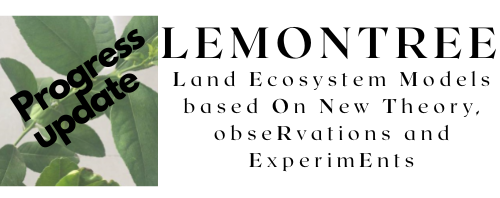
We recently submitted our end-of-year report to our funders, bringing us into year 4 of our five-year project. Where has the time gone? Year 3 has been rather transformative, marked by significant scientific advancements and structural changes to enhance our research efforts. Here’s a comprehensive overview of what we’ve accomplished.
We’ve restructured!
A major highlight of Year 3 was the restructuring of our project into seven specialized working groups. 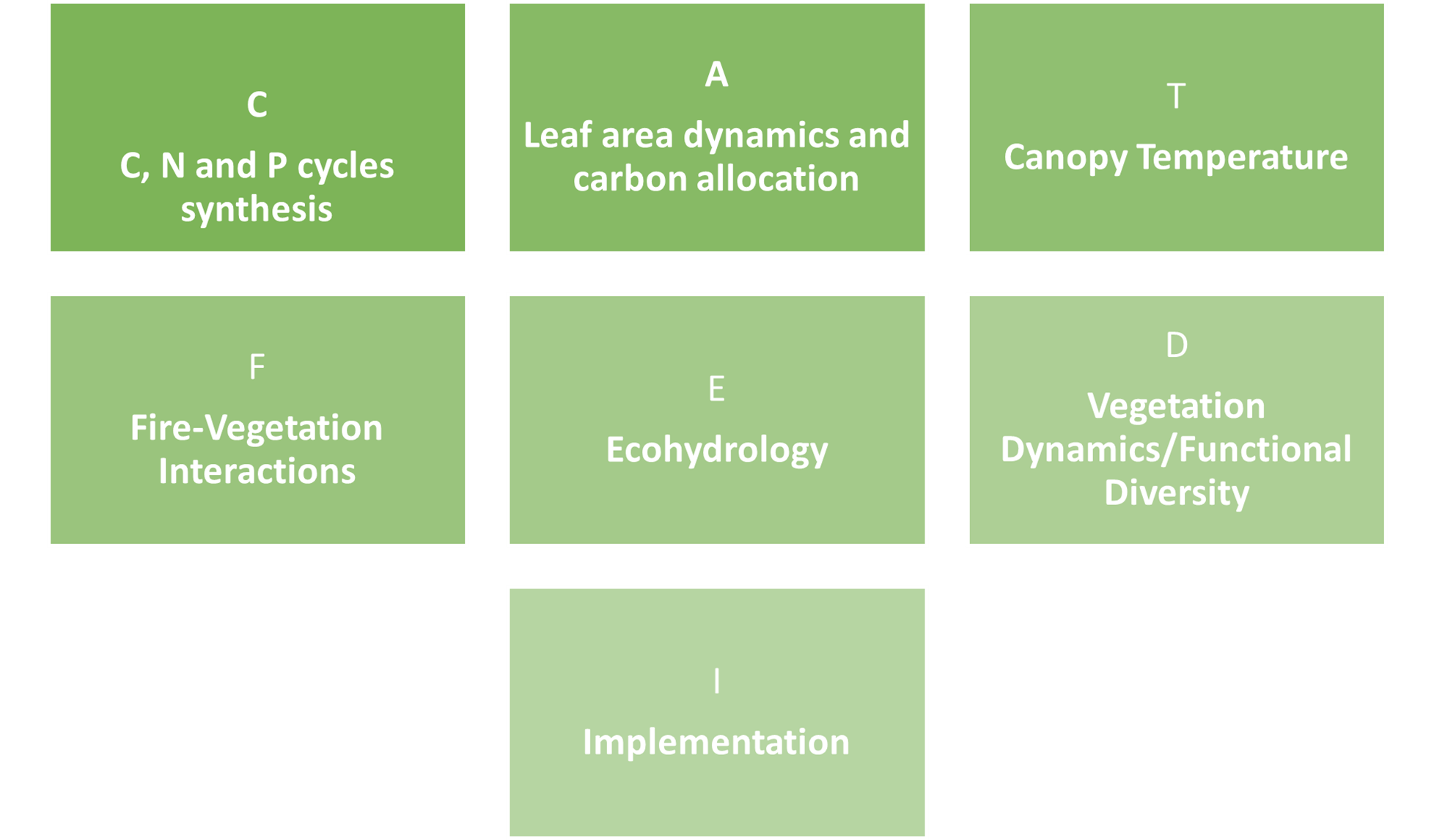
Each group is led by one of our Principal Investigators and coordinated by an Early Career Researcher. This new structure has fostered better coordination and allowed us to refine and prioritize our tasks more effectively. Here are the key benefits of this transition:
- Improved coordination among related research topics.
- Reassessment and refinement of our task list based on research insights from the first half of the project.
- Enhanced opportunities for early-career researchers to lead and contribute significantly to LEMONTREE science.
- Better collaboration between our team members that are spread out across the globe.
Highlights of Our Scientific Progress
1. Optimality-Based Model for Leaf Area Dynamics
We developed a prognostic model for the seasonal and interannual variability of leaf area index (LAI). This model, which predicts maximum vegetation greenness, outperforms current models in the TRENDY project. LAI is determined by energy and water limitations, representing the lesser of an energy-limited value that maximizes gross primary production (GPP) and a water-limited value that supports photosynthesis through transpiration. The LAI time course follows, with some lag, the steady-state values of LAI and GPP, determined using the Lambert W function.
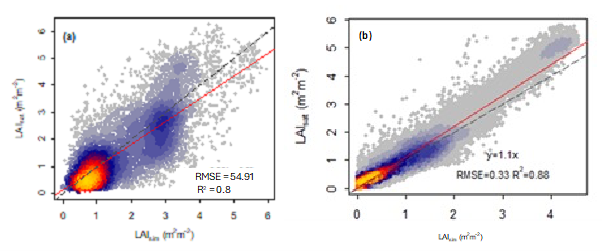
Figure 1: Optimality model for predicting dynamics of leaf area: Agreement between satellite-observed and modelled (a) multi-year average leaf area index (LAI) and (b) 7-day averaged LAI
2. Quantum Yield of Photosynthesis and Temperature
Our research, using experimental and flux tower data, confirms that the intrinsic quantum efficiency of C3 photosynthesis (φ0) follows a universal bell-shaped curve, with the optimum shifting as temperature increases. This crucial finding demonstrates that temperature affects how efficiently photons are used for CO2 uptake by plants. We have developed a method to incorporate this relationship into our modelling framework, addressing a gap in current models.
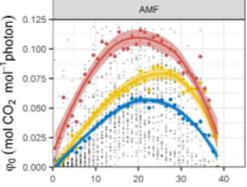
Figure 2: Intrinsic quantum efficiency analysis: 95th (red), 75th (yellow) and 25th (blue) percentiles of φ0 based on Ameriflux sites with in situ measured fAPAR.
3. Plant Functional Diversity
Intensive sampling of water and soil nutrients at three sites in China allowed us to analyse functional diversity. While trait-environment relationships vary between sites due to different resource strategies, trait relationships are consistent, particularly with leaf phosphorus content. This work aligns with our progress in understanding nitrogen controls on vegetation growth through lab and field data, leading to a successful model linking carbon and nitrogen cycle dynamics.

Figure 3: Plant functional diversity: Trait dimensions from principal component analysis (PCA). Yellow circles and red triangles are species at two phosphorus-poor and wet sites. Green squares are species at the dry soil phosphorus-rich site.
4. Empirical Analyses of Wildfire Drivers
Our analysis of changing wildfire regimes shows that landscape fragmentation affects burnt areas differently across ecosystems. Fragmentation reduces burnt areas in ecosystems adapted to frequent fires, like savannas and Mediterranean forests, but increases them in tropical broadleaf and boreal needleleaf forests. Fire size, burnt area, and intensity are influenced by different factors, and these relationships may become decoupled in a changing climate. Our empirical framework is essential for redesigning process-based fire-vegetation models and coupling the P+ model to the dynamic vegetation module in land-surface models (LSMs). We have also made strides in developing benchmarks for our P+ model implementation in LSMs.
5. Ecohydrology Insights
We explored factors contributing to differences between potential evapotranspiration from standard benchmark data sets, revealing their unreliability for model evaluation. We developed a new approach to partition evapotranspiration into transpiration and evaporation (T/ET) using long-term hydrological data from the US. This approach provides a crucial benchmark for evaluating model performance when integrated into land-surface schemes.
6. P+ Model Implementation in LSMs
We have made significant progress in implementing our Eco-Evolutionary Optimality (EEO) model in land surface models (LSMs) like Noah-MP and JULES. Achievements include implementing the acclimated photosynthesis scheme within JULES and comparing its simulated GPP and energy fluxes with the standard multi-layer canopy model. We also implemented acclimated photosynthesis and leaf respiration schemes in Noah-MP, significantly improving model performance. Our EEO-based scheme, with only three parameters, captured 69% and 62% of temporal and spatial variations in leaf respiration, respectively. It produced more realistic estimates of half-hourly GPP at flux sites compared to the standard scheme, which often underestimates GPP and shows a larger spread in R² across sites. The standard scheme also overestimates canopy respiration and predicts larger fluctuations than the EEO scheme (R²: 0.45 vs. 0.77).
Conferences and Publications
LEMONTREE science was well-represented at several international conferences and workshops in Year 3. In 2024 so far, the LEMONTREE team has attended the following:
- CESM Land Surface Model Working Group (February 2024)
- EGU in Vienna (April 2024)
- ISIMIP & PROCLIAS Workshop in Potsdam (April 2024)
- Uncertainty, Climate Change, and Policy Challenges (May 2024)
- Mathematical Models in Ecology and Evolution in Vienna (July 2024)
- Remote Sensing and Fluxes for Real-World Impact in Berkeley (July 2024)
And we’ve got a busy summer and autumn term coming up with multiple workshops and conferences to prepare for, starting with the annual meeting of the Ecological Society of America in August. We have also maintained a robust presence in the peer-reviewed literature, with 16 papers published since our mid-term review in October 2023 (listed below).
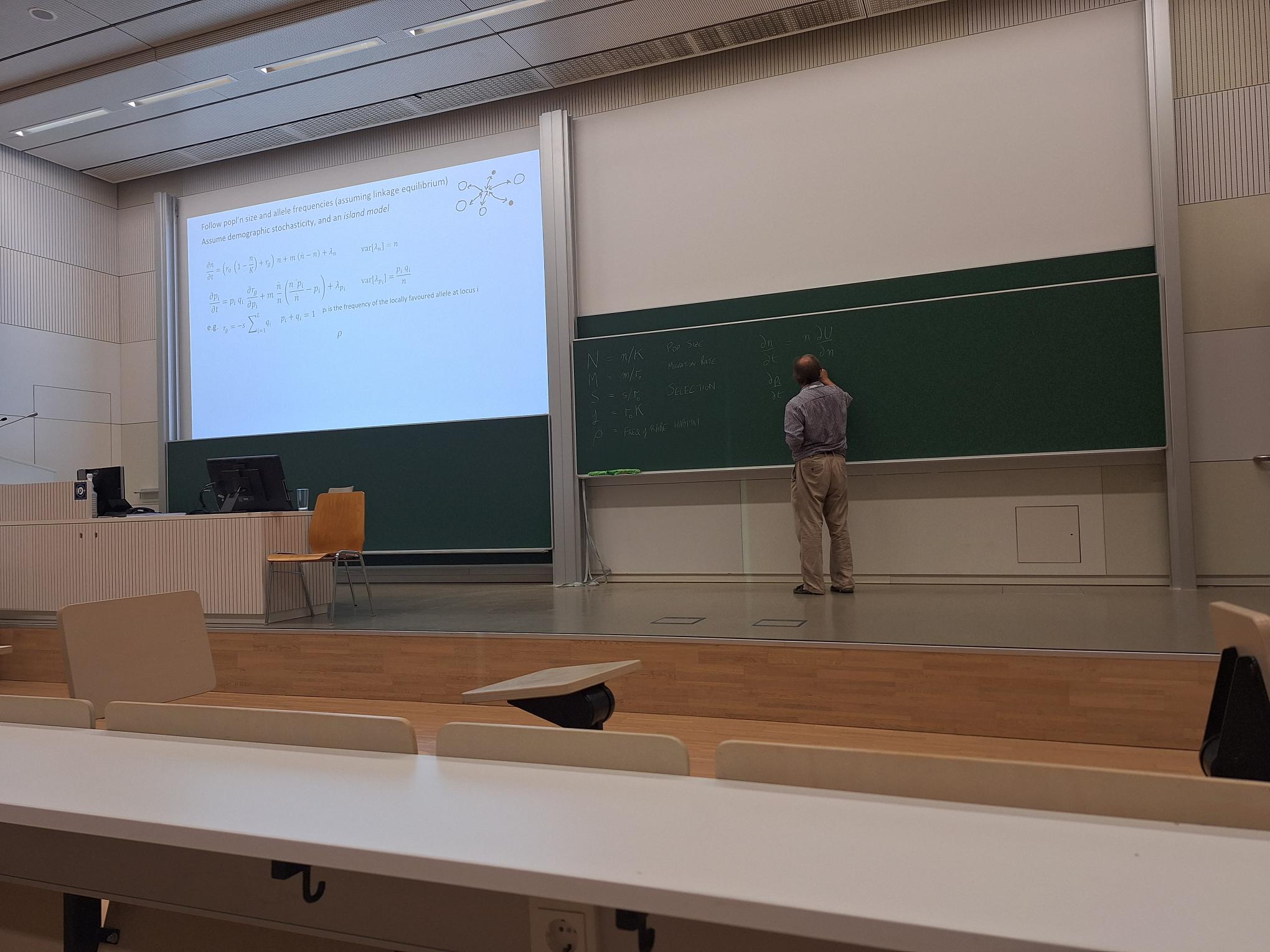
Figure 4: Image taken by Dominic Robson at a seminar at the Mathematical Models in Ecology and Evolution conference in Vienna earlier this year.
Looking Ahead
The working groups at LEMONTREE have clear and focused goals for advancing our understanding of ecological processes. WG A aims to develop an algorithm for plant carbon allocation based on environmental factors and test its predictions on vegetation characteristics. WG C is working on integrating nutrient cycles into models, specifically assessing phosphorus data and land carbon sink trends. WG T investigates canopy temperature dynamics, assessing differences from air temperature, controls on canopy temperature, and the reliability of land surface temperature products. WG F focuses on creating a new fire-vegetation interaction model that realistically simulates fire regimes and plant responses. WG D seeks to understand vegetation trait coordination and dynamics to improve land surface models. WG E studies plant-water interactions, analysing precipitation use and vegetation behaviour in water-limited sites.
Next month, the team will convene in Utrecht for our annual project meeting, followed by a summer school where our Early Career Researchers will gain valuable training and expertise from our Principal Investigators. We have made significant strides over the past year, but the coming year promises to be our most productive and impactful yet.
We’ve got lots of work ahead, but first, many of us hope to enjoy a well-deserved break over the summer, and we hope you do too!
Published since the mid-term review (Oct 2023)
Blackford, K.R., Kasoar, M., Burton, C., Burke, E., Prentice, C., Voulgarakis, A., 2024. INFERNO-peat v1.0.0: A representation of northern high latitude peat fires in the JULES-INFERNO global fire model. Geoscientific Model Development 17: 3063-3079, https://doi.org/10.5194/gmd-17-3063-2024
Giardina, F., Gentine, P., Koning, A.G., Seneviratines, S.I., Stocker, B.D., 2023. Diagnosing evapotranspiration responses to water deficit across biomes using deep learning. New Phytologist. 240: 968-983, https://doi.org/10.1111/nph.19197
Green, J.K., Zhang, Y., Luo, X, Keenan, T.F., 2024. Systematic underestimation of canopy conductance sensitivity to drought by Earth System Models. AGI Advances 5: e2023AV0001026.
Keenan, T. F., Luo, X., Stocker, B. D., De Kauwe, M. G., Medlyn, B. E., Prentice, I. C., Smith, N. G., Terrer, C., Wang, H., Zhang, Y., Zhou, S., 2023. A constraint on historic growth in global photosynthesis due to rising CO2. Nature Climate Change 13: 1376-1381, https://doi.org/10.1038/s41558-023-01867-2
Keeping, T., Harrison, S.P., Prentice, I.C., 2024. Modelling the daily probability of wildfire occurrence in the continguous United States. Environmental Research Letters 19: 024036, https://doi.org/10.1088/1748-9326/ad21b0
Kladny, K.-R., Milanta, M., Mraz, O., Hufkens, K., Stocker, B. D., 2024. Enhanced prediction of vegetation responses to extreme drought using deep learning and Earth observation data, Ecological Informatics 80: 102474, https://doi.org/10.1016/j.ecoinf.2024.102474
Lian, X., Penuelas, J., Ryu, Y., Piao, S., Keenan, T., Fang, J., Yu, K., Chen, A., Zhang, Y., Gentine, P., 2024. Diminishing carryover benefits of earlier spring vegetation growth. Nature Ecology and Evolution 8: 218-228. https://doi.org/10.1038/s41559-023-02272-w
Luo, X., Zhou, H., Satriawan, T.W., Tian, J., Zhao R., Keenan, T.F. Griffith, D.M., Sitch, S., Smith, N.G., Still, C.J., 2024. Mapping the global distribution of C4 vegetation using observations and optimality theory. Nature Communications 15: 1219. https://doi.org/10.1038/s41467-024-45606-3
Peng, Y., Prentice, I.C., Bloomfield, K.J., Campioli, M., Guo, Z., Sun, Y., Tian, D., Wang, X., Vicca, S., Stocker, B.D., 2023. Global terrestrial nitrogen uptake and nitrogen use efficiency. Journal of Ecology 111: 2676–2693. https://doi.org/10.1111/1365-2745.14208
Ren, Y., Wang, H., Harrison, S.P., Prentice, I.C., Atkin, O.K., Smith, N.G., Mengoli, G., Stefanski, A., Reich, P.B., 2024. Reduced global plant respiration due to the acclimation of leaf dark respiration coupled with photosynthesis New Phytologist 241: 578-591, doi: 10.1111/nph.19355
Ren, Y.H., Wang, H., Yang, K., Li, W., Hu, Z.M., Ma, Y.M., Qiao, S.C. 2024. Vegetation productivity slowdown on the Tibetan Plateau around the Late 1990s. Geophysical Research Letters 51: e2023GL103865 (Mistakenly omitted acknowledgement of Lemontree)
Ruehr, S., Keenan, T.F., Williams, C., Zhou, Y., Lu, X., Bastos, A., Canadell, J.G., Prentice, I.C., Sitch, S., Terrer, C., 2023. Evidence and attribution of the enhanced land carbon sink. Nature Reviews Earth & Environment 4: 518–534 (2023). https://doi.org/10.1038/s43017-023-00456-3
Sandoval, D., Prentice, I.C., Nobrega, R., 2024. Simple process-led algorithms for simulating habitats (SPLASH v.2.0): calibration-free calculations of water and energy fluxes. Geoscientific Model Development. 17: 4229-4309.
Waring, E.F., Perkowski, E.A., Smith, N.G., 2023. Soil nitrogen fertilization reduces relative leaf nitrogen allocation to photosynthesis. Journal of Experimental Botany 74: 5166-5180. https://doi.org/10.1093/jxb/erad195.
Xu, H., Wang, H., Prentice, I.C., Harrison, S.P., 2023. Leaf carbon and nitrogen stoichiometric variation along environmental gradients. Biogeosciences 20: 4511-4525, https://doi.org/10.5194/bg-20-4511-2023.
Xu, S., Gentine, P., Li, L., Wang, L., Yu, Z., Dong, N., Ju, Q., Zhang, Y., 2023. Response of ecosystem productivity to high vapor pressure deficit and low soil moisture: Lessons learned from the global eddy-covariance observations. Earth’s Future. 11: e2022EF003252. https://doi.org/10.1029/2022EF003252
